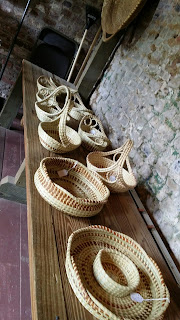Tuesday
You can't be in the South without seeing at least one plantation.
That is what the old South is all about.
And it must have an entry of old Oak trees hung with Spanish moss.
Boone Plantation just north of Charleston qualified, so here I am.
It is the most photographed of all the plantations and has been in a number of movies and on TV.
Heck, Wheel of Fortune even did a show from here.
The 3/4 mile long row of Avenue of Oaks was planted in 1743 by the son of the original owner. Today the Spanish moss swaying gently in the breeze from the Oaks is world famous.
Approaching the house off to the left is a row of slave cabins and on the right side of the road is a pasture of thoroughbred horses, one of which sired Secretariat back in the day.
The original plantation was begun in 1683 by Major John Boone, an Englishman who built a modest frame home on the property which later burned down. Another larger second home was built which was destroyed by a hurricane. The third home was a 3,000 sq ft frame farm house which had been neglected for 100 years. So in 1935 it was torn down to build the present 10,000 sq ft Federal Colonial Georgian style home we see today.
Particularly attractive are the two shade structures for tourists in front, don't you agree?
It is on the National Historic Register as the oldest working plantation in America, continuously growing crops like rice, indigo and cotton for the last 300 years on 735 acres today.
We toured the home which is owned by a family that lives there so couldn't see the upstairs and no photos allowed.
From there we went out to the slave quarters which was the more interesting part of the tour.
These cabins are the original on the site and are built of bricks which were made on the plantation, one of their many businesses. Bricks made here were used to build Fort Sumter.
The defective bricks were used for these slave quarters.
These cabins were for the house slaves or slaves with particular skills so they had better living conditions. Field slaves lived in log cabins near the fields. Those cabins didn't survive the last 200 years.
In 1860 there were 4 million slaves in the South. 4 million! They could have had an uprising and taken over. Wish they had. They tried a few times unsuccessfully.
Each cabin had a recording for information on different aspects of the life of slaves on the plantation.
This woman is weaving traditional baskets made of sweet grass.
She learned the skill from her grandmother.
This is one of the oldest traditional African art forms passed from generation to generation in the U.S.
The baskets were used to separate the rice from its cover. When the rice was tossed in the air the shell came off and the heavier rice kernels settled in the bottom of the basket.
Inside the carpenter's cabin was furniture that he
had made and probably made furniture for the other cabins as well.
They all had wood floors as opposed to the field hand log cabins which had dirt floors.
Inside one of the cabins was a history of the slave trade in Charleston showing all of the ships that came in between 1711- 1858.
This very detailed record showed the name of the ship, where it came from, how many slaves embarked, and how many disembarked. They lost around 20% of their slaves on the trip due to terrible conditions on the ships.
The Anti-Slavery Act was passed in 1805 making it illegal to bring slaves from Africa, but they could be brought in from other places.
In the mid 1800s Charleston was the third largest city in the US due to the cotton industry and slaves.
This original cotton gin on the property was falling apart and needed to be propped up.
It had been used as a tourist restaurant and gift shop but recently closed.
At one of the slave cabins we heard a wonderful Gullah black history presentation by an older woman named Gloria who told stories, sang songs and told her family history. Her grandmother died at 117 and had been a slave.
For one of the stories she told the Brer Rabbit Uncle Remus story and asked for volunteers. So I was the Tar Baby. Fun!
I remember hearing the story as a kid and now I got to be part of it as Gloria told the story in her wonderful southern Negro accent. Gullah is a language combining African and English.
The Boone Plantation was one of the first in the area to teach their slaves to read and write.
According to our guide they were treated better than most here but still regarded as property.












No comments:
Post a Comment